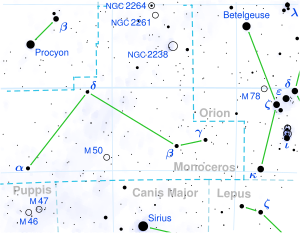S Monocerotis, also known as 15 Monocerotis, is a massive multiple and variable star system located in the constellation Monoceros. It is the brightest star in the Christmas Tree open cluster in the area catalogued as NGC 2264.

S Monocerotis is found within an open cluster and the Washington Double Star Catalog lists many companion stars.[18] The closest and brightest is S Mon B, magnitude 7.8 and 3 arcseconds away. It is classified as B2 main sequence star with a mass of 7.31 M☉. Designated component C is an 11th-magnitude B8V star.[6] The cluster contains another dozen or so 9th and 10th magnitude stars and many fainter stars.
S Monocerotis A is a spectroscopic binary system with an eccentric orbit of about 112 years.[13] Since 1943, the spectrum of this star has served as the MK standard for O7 by which other stars are classified.[19] It is also an irregular variable star with a range of less than a tenth of a magnitude. The orbital parameters can be used to derive the masses of the two stars, giving 31 M☉ and 11 M☉.[6]
The distance to S Monocerotis and NGC 2264 has been derived in various ways, including dynamical parallax and isochrone fitting. These consistently give estimates of 700 - 900 parsecs, although this is double the likely distance derived from the Hipparcos parallax measurements.[9] Gaia Early Data Release 3 contains parallaxes for the companions components B and C of 1.4 mas and 1.5 mas respectively, consistent with the expected distance to the cluster.
